The Big Muff π Page
The Definitive Big Muff Resource and History
VISIT MY SWORDS, KNIVES and FANTASY ART WEBSITE www.kitrae.net

Written January 2012 ©Kit Rae. Last update February 2024.
PART 1 • PART 2 • PART 3 • PART 4
In an attempt to show the evolution of the transistor based Big Muff Pi circuit, and a reference for repairs, this article examines some key schematics for the different vintage Electro-Harmonix variants, in chronological order, or as near as I can determine. Also included are several clones of the Big Muff circuit with unique component values or interesting modifications. The Big Muff Pi was, and still is one of the most cloned circuits in the history of effects pedals. I have tried to give traces of only variants that sound different from each other, or that were the more common circuits for a particular version.
This article is for educational purposes, as a reference for repairs, to show a history of the circuit changes throughout the years, and offer up some of the more interesting and inventive changes the DIY community and cloners have done with the circuit that you home tinkerers may try. Production or boutique clones of the BMP circuit that have been off the market for a long while, or that use commonly known mods, are open game for anyone to post schematics as far as I am concerned. For current clones still in production, I have tried not to post the entire schematics, just the Big Muff part of the circuit, or anything else copied or modded from an EHX circuit or a using a common modification to the circuit that previously existed. I will not post the schematics of anything in the current EHX line, like the current Big Muff, Tone Wicker Big Muff, or Bass Big Muff, so don't even ask. I am not interested in doing anything that may damage EHX business, or to help anyone clone their current products. THE PEDALS THAT ARE CURRENTLY IN PRODUCTION ARE ALL RELTIVELY INEXPENSIVE, SO I HIGHLY ENCOURAGE YOU TO BUY ONE.
For some insight on how the circuit works, check out this page: Muff Guts - THE BIG MUFF CIRCUIT - How it Works
REPAIRS - Since there were so many variant schematics used that are similar to others, I have not shown every one in this article. I do have practically every schematic however, so if you are making a repair and need to verify a component value, email a photo of the circuit, say please, and I can email you the schematic for that variant: nasnandos @ kitrae.net.
If you are a do-it-yourself home tinkerer, the best way to try out the different versions and mods is to socket everything so you can trade out different caps and resistors. Each of these schematics have been double checked, and most are verified, but I don't guarantee each one is absolutely perfect. If you spot a mistake, or know of another unique variant or would like to contribute to The Big Muff Page, email me: nasnandos @ kitrae.net.
WHY DID ELECTRO-HARMONIX CHANGE THE PRODUCTION SCHEMATIC SO OFTEN? - There are many reasons, but the simple answer seems to be, to fit the parts on hand at the time. Caps and resistors were bought in bulk, and exact values from batch to batch varied. For example, if 500pF caps were not available, 560pF caps were substituted, and other related cap and resistor values tweaked in an attempt to keep a similar sound. If there was a surplus of 33k resistors, you may see them used in R2, R5, R8, R13, and R11 positions. The next run could change to 27k. Basically, wherever there were changes they could get away with and not drastically affect the sound, they did it, but often these changes did affect the sound. There were hundreds to thousands of each variant circuit made, at least until the next bulk purchases required the schematic to be tweaked again for the next production run. At other times the schematic was intentionally changed specifically to revise or update the sound.
VERSIONS are typically defined by enclosure changes or major color and graphics changes. Within each version are numerous circuit VARIANTS, each with unique sets of component values and types. These variants were each made in large production runs. Determining the release year order was based on pot dates, circuit board colors and markings, component types, differences in enclosure graphics, rubber foot styles, knob styles, advertising dates, and other features. Examining each of those gives a clear chronology. For a mostly complete rundown on the release dates of the Big Muff variants, visite the Fuzz and Muff Timeline page.
DON'T ALL BIG MUFFS SOUND THE SAME? - Some do, and many do not. The BMP circuit is very forgiving of minor value changes, so some of these variants do not sound significantly different from one another, but others sound very different. Using a clean amp with lots of head room and single coil guitar pickups (my preference) will allow you to clearly hear the differences in the variants and clones. Using humbuckers through a dirty amp will tend to make many of these sound similar, since a dirty amp will color the tone of the distortion.
WHY ARE THE TRANSISTORS LABELED IN THE REVERSE ORDER? - Note that Q1-Q4 and D1-D4 are labeled in reverse order from input to output on these schematics, the reverse of what they they are on a typical schematic. This is due to the fact that they are printed in this order on the actial V1, V2, and V3 Big Muff PCB's. To keep it from being confusing for those reading their PCB's, since this site originated primarily as a reference for vintage Big Muff owners, and to keep the EH tradition, we have used this order on all Big Muff schematics, including post 1980's Big Muffs. If you are just making a clone and your brain can't handle this, don't cry, just reverse the number order. I have also tried to keep the cap and resistor part numbers consistent from schematic to schematic.
VERSION 1 "TRIANGLE" BIG MUFF PI - Approximately 18 circuit variants exist, each made in extended manufacturing runs.
V1 "PERF BOARD" TRIANGLE BIG MUFF PI - This is where it all started. An early perf board version from late 1969-early 1970 of the original Bob Myers/Mike Matthews circuit design, with some point-to-point wiring. This was from the very early days of Electro-Harmonix, when the company consisted of just a few employees. The core circuit layout was established right from the start, but I have seen three slightly different circuit variants of this perf board version, with changes listed in the schematic below. The unusually large 39k collector resistors at R13 and R11 were unique to this variant. The combination of those large value resistors and the other component values made this version have a very massive, high gain sound. Even with the sustain dialed to zero, there was still plenty of drive coming through the circuit. It had more low end and gain than the later variants, but some tended to sound a bit muddy and bassy. These component values would change and be refined as the circuit was revised for later production.
Note that I forgot to include the polarized electro directions in the schematic below. Typically + should point toward the nearest transistor, although this was not always the case. The Silicon diodes are listed here as 1N914 but the actual diode types used are unknown. They had various markings such as SYL GD938, SYL GY925 926, or GY819. Based on measurements, and the diodes used in later Big Muff versions, these measure about 0.5 - 0.6V, so some modern equivalents that work similarly are 1N914 or 1N4148.
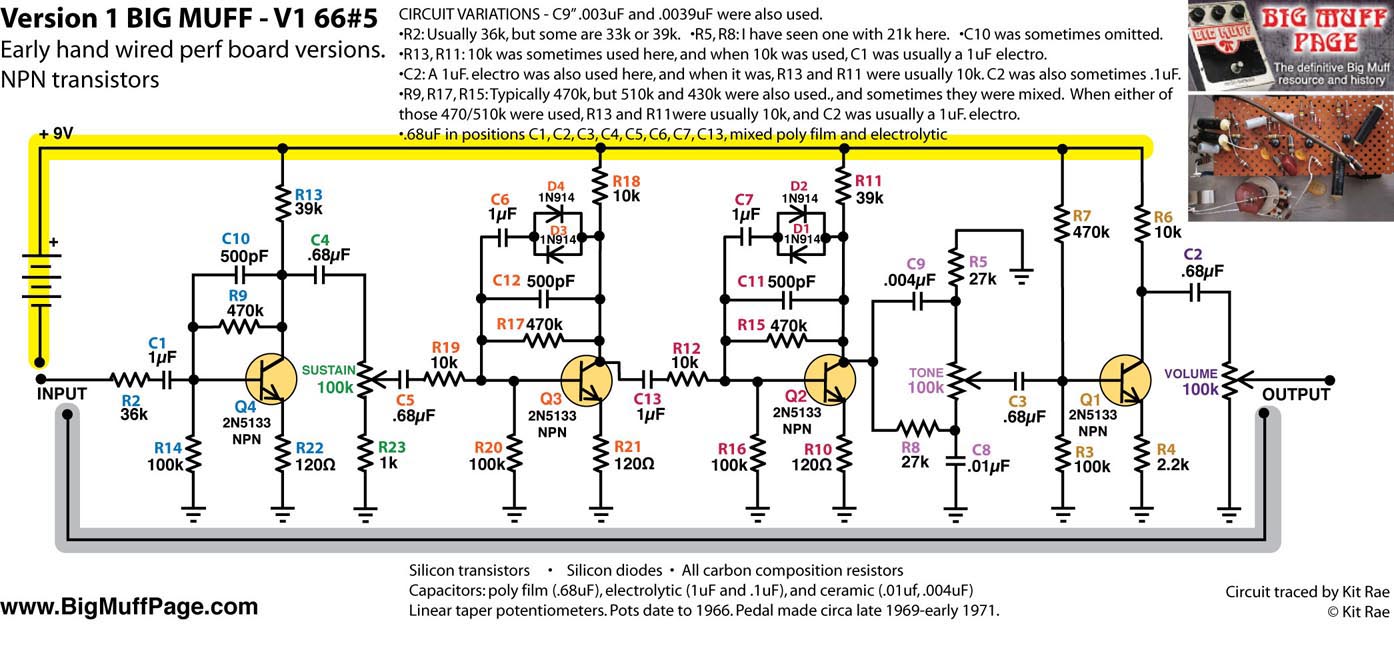
V1 "3µF" TRIANGLE BIG MUFF PI - This variant is from around 1970. It is very similar to the perf board version shown above, but with one major change that makes this one of the most uncommon circuit variants of the V1 Big Muff. The input/output caps, coupling caps, and and clipping caps were all large 3µF electrolytics, not found on any other version of the Big Muff Pi. It had a very fat, high gain sound. This exact variant was also made with 1µF caps in those positions. 1µF and .1µF would later become the standard.
Note that the Silicon diodes are listed here as 1N914 but the actual diode types used are unknown. They had various markings such as SYL GD938, or SYL GY925 926, or GY819. Based on measurements, and the diodes used in later Big Muff versions, these measure about 0.5 - 0.6V, so some modern equivalents that work similarly are 1N914 or 1N4148.
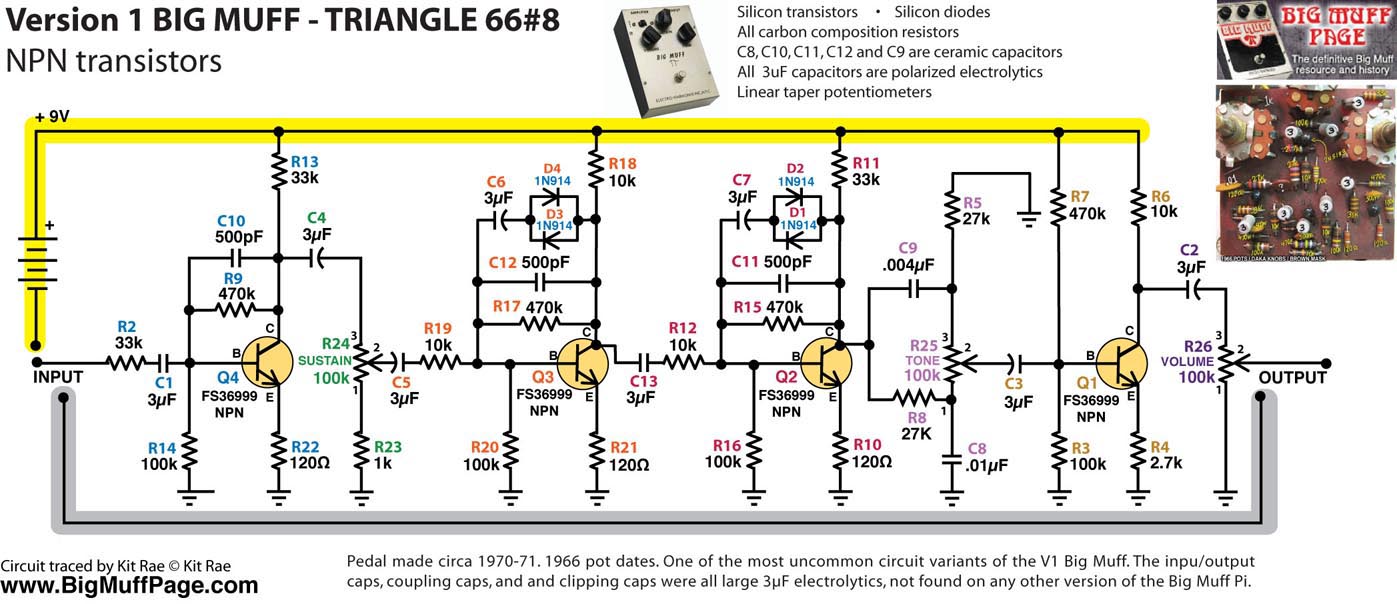
V1 TRIANGLE BIG MUFF PI - This variant is from around 1970-71. Similar to the example shown above, but minor component value changes were made across the circuit. The R2 input resistor was reduced slightly to increase the signal. Clipping stage input resistors at R19 and R12 were enlarged to 12k for slightly less crunch and drive. Feedback resistors at R9/15/17 were dropped to 390k for less gain, but the collector resistors at R13 and R11 were also reduced slightly to increase the gain in the clipping stages. R5 and R8 were reduced to 22k for a more scooped mid range. The result was a smooth distortion, slightly less gain when the sustain knob was maxed, but still with a mean, deeply scooped mid range.
Note that the Silicon diodes are listed here as 1N914 but the actual diode types used are unknown. They had various markings such as SYL GD938, or SYL GY925 926, or GY819. Based on measurements, and the diodes used in later Big Muff versions, these measure about 0.5 - 0.6V, so some modern equivalents that work similarly are 1N914 or 1N4148.
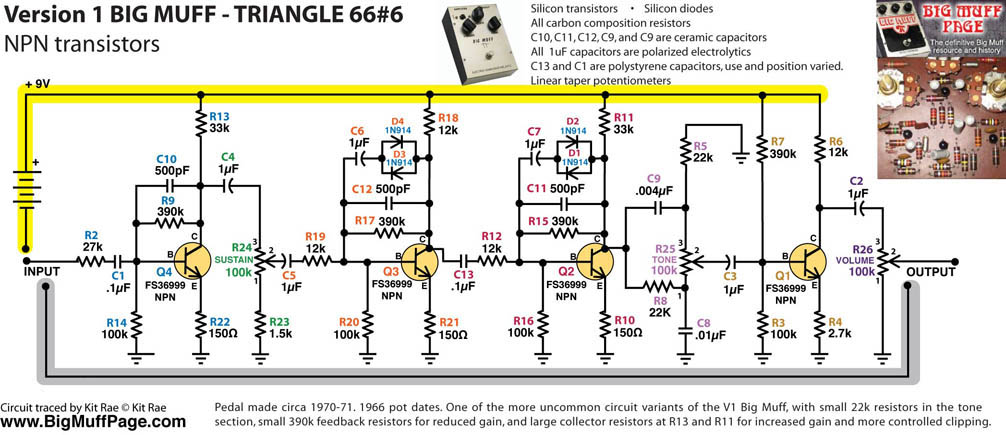
JORDAN CREATOR - One of the first clones of the V1 Big Muff, from around 1971. This is often referred to as a triangle Big Muff spec clone, and I suspect it was based on values from a real V1 variant, but Jordan may have tweaked their own version of the circuit. Component values do not exactly match (at least as far as what I have seen) any of the 8 or 10 V1 variants that were on the market before the time the Creator was made, or the variants that came after. The fact that they removed C10 just as EHX was doing at the time indicates it likely started as a straight clone (see Triangle 66#11 below). The small 220k and 270k feedback resistors combined with the large 560pF clipping caps and large 33k collector resistor at R13 and R11 give it a very clear and cutting, but smooth distortion, with lots of bottom end. One of the best sounding clones of the BMP ever made, in my opinion.
Note that I have not shown the switching for the volume pedal feature of this circuit, primarily because I thought it was a stupid and clumsily executed idea. The low level signal does not get loud enough to even meet an average unity level of most other pedals from the time, nor is the switching setup practical. It would have better to simply wire in a standard 100k volume pot like a typical BMP.
I have written more about Jordan and the Creator here.
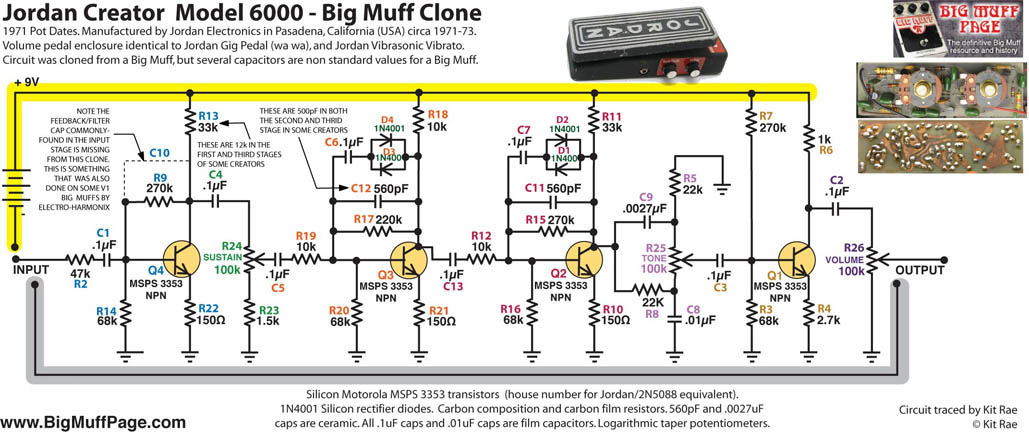
V1 "GREEN CAP" TRIANGLE BIG MUFF PI - This is one of the common circuit variants, from around 1971, easily identified by the large green capacitors used. It seems to be the fourth circuit variant for the V1. The low pass filter cap at C10 in the input stage was omitted, likely because of a shortage of 500pF caps during that production run. The 10k input resistors at R19 and R12 were reduced to 8.2k, and remained this way on most V1 variants that came later. This boosted the gain into the clipping stages, giving a bit more drive and crunch. Most of the Big Muffs I have seen with this same circuit variant had .1uF caps where my V1 of this variant uses .12uF. The same circuit was also used in the Guild Foxey Lady OEM version.
Note that the original Silicon diodes are marked SYL GY925 926, but the actual diode types used are unknown. 1N914 (shown on the schematic) and 1N4148 are some modern equivalents that work, but they may not be identical to the original diodes. The differences are minor, but diode types do affect the sound frequencies that are clipped.
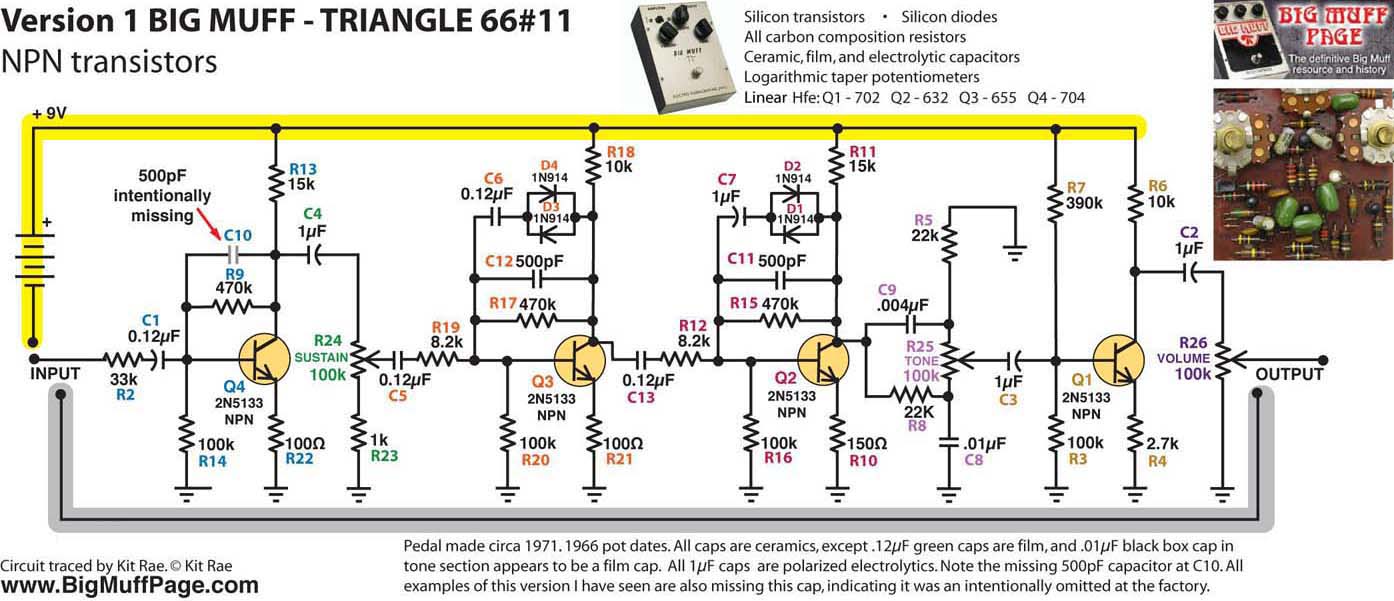
V1 "STANDARD" TRIANGLE BIG MUFF PI - Circa 1971. This is the most common variant of the V1 circuit, although it is rarely cloned. I estimate that 60-70% of all vintage triangle Big Muffs used this exact circuit. Electros were dropped in favor of ceramics and a few film caps, but the primary change for this variant was the larger 33k resistors at R5 and R8 in the tone section, for a slight reduction in the mid range frequency scoop. If one version could be said to have that "triangle" sound, this would have to be it. The same circuit was also used in the Guild Foxey Lady OEM version. The Skreddy Pedals Mayonnaise was cloned from a variant similar to this, but with but with larger resistors at R11 and R13.
Note that the original Silicon diodes are marked SYL GY920, but the actual diode types used are unknown. 1N914 (shown on the schematic) and 1N4148 are some modern equivalents that work, but they may not be identical to the original diodes. The differences are minor, but diode types do affect the sound frequencies that are clipped.
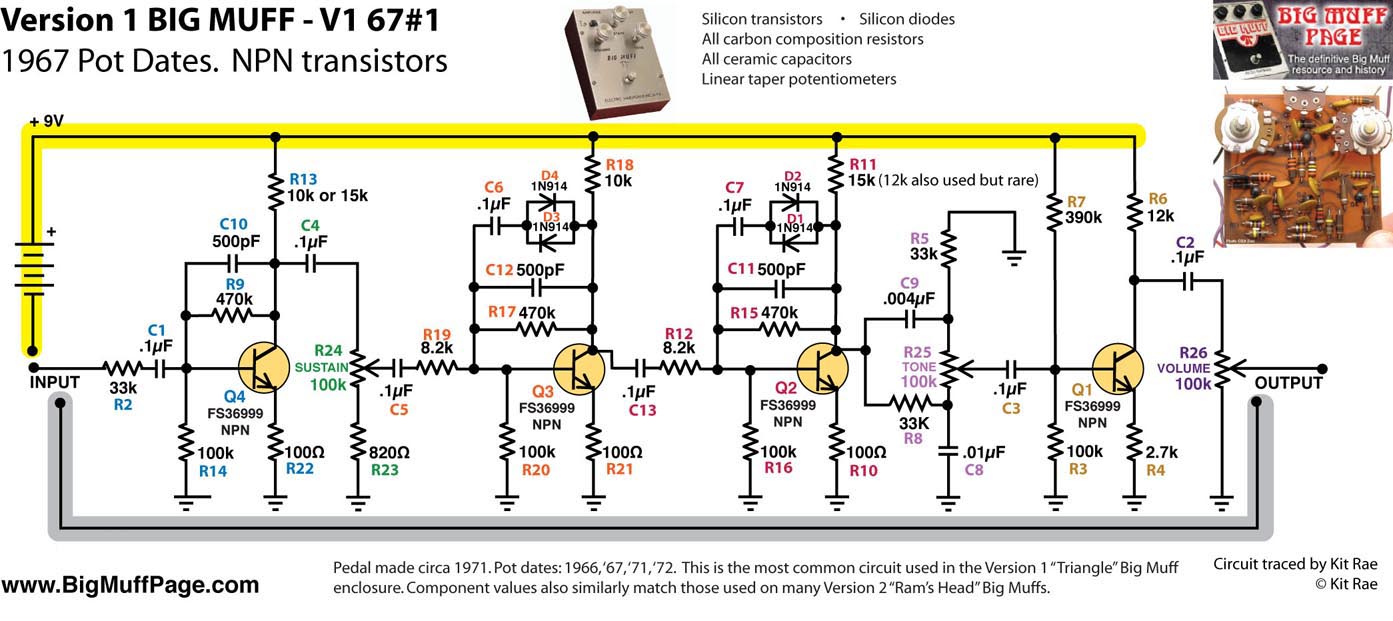
ACE TONE FUZZ MASTER FM-3 - A rare early clone of the V1 Big Muff, circa 1971-73, and one of the first modified BMP circuits. This is a little known clone, often mistakenly thought to be a variant of the Roland Bee-Baa circuit. Ace Electronic Industries was founded by Ikutaro Kakehashi, who later founded Roland in March 1972. Prior to that Ace made the FM-1 which was a Maestro FZ1-A clone, and the FM-2, which was a Univox Super Fuzz clone, and the FM-3, possibly the first Japanese Big Muff clone. It was a very unique version of the circuit, incorporating a switchable volume boost stage (shown in red), allowing switching between distortion and boost (sadly, not combinable), with separate volume and tone pots for each.
The boost stage was simply a separate tone and volume circuit for the input stage, identical to the one in the tone stage, and not really much of a booster. Including a set of clipping diodes in the input stage that switched in when the booster was engaged would have been a better idea. The Big Muff part of the circuit seems to be based on the "standard" V1 schematic shown above, but the mods make it sound very different. These include a huge 150k collector resistor at R13, reducing and smoothing out the input stage gain, while the small filter cap at C10 clips more highs than a typical BMP circuit. There is also an extra filter cap parallel to the R2 input resistor and two extra resistors at R27 and R32. The volume pot, normally placed after the output stage, has been moved between the tone stage and output stage. The C10/11/12 feedback/filter caps are much smaller than the stock Big Muff caps, giving more crunch, but less low end than a typical Muff. Since the Big Muff part of the circuit follows the stock trace, you can substitute component values from any BMP schematic.
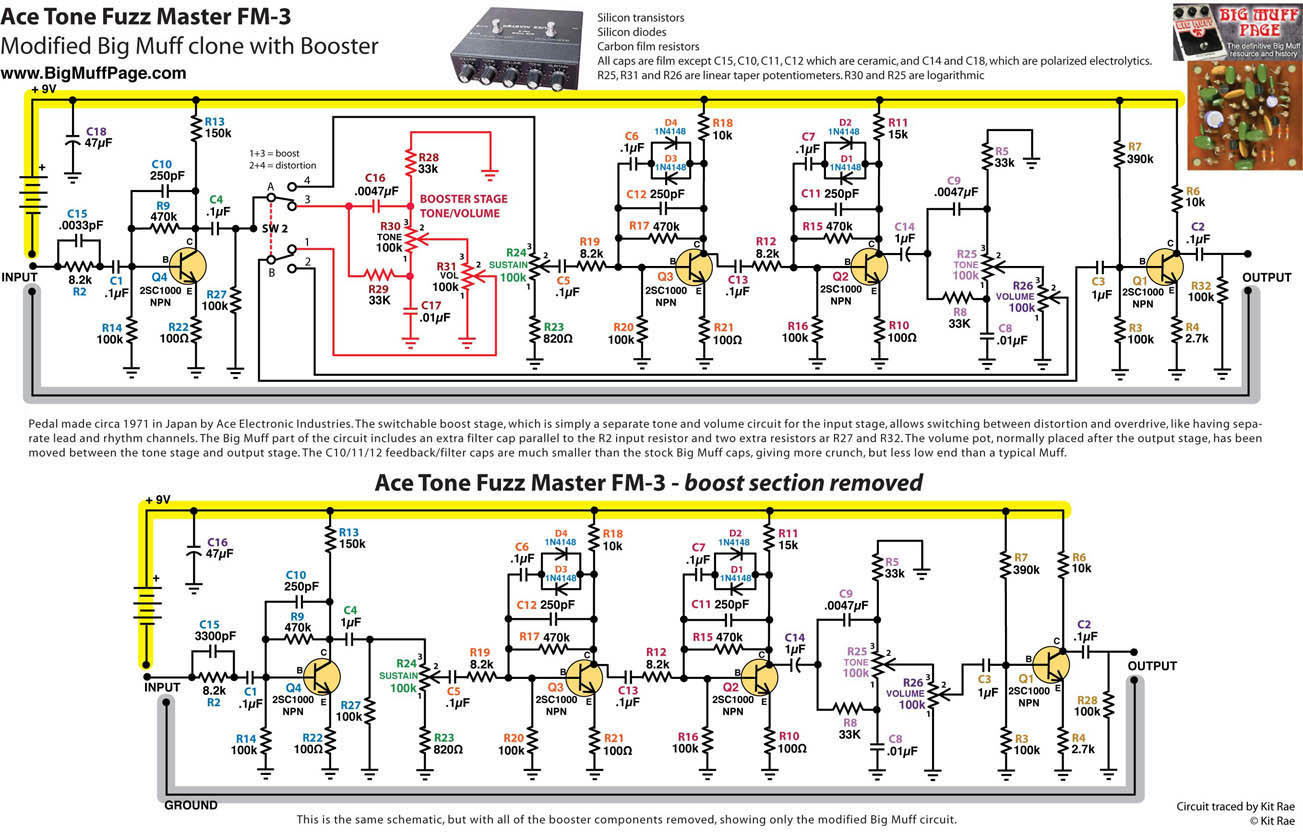
V1 TRIANGLE BIG MUFF PI - Another variant from 1972 with rarely used .05µF clipping caps. Low clipping cap values normally makes for a bassier sound, but the low .1µF cap values in other parts of the circuit keep it in check. Otherwise it is very similar to the V1 67#1 schematic shown above.
Note that the original Silicon diodes are marked SYL GY925 926, but the actual diode types used are unknown. 1N914 (shown on the schematic) and 1N4148 are some modern equivalents that work, but they may not be identical to the original diodes. The differences are minor, but diode types do affect the sound frequencies that are clipped.
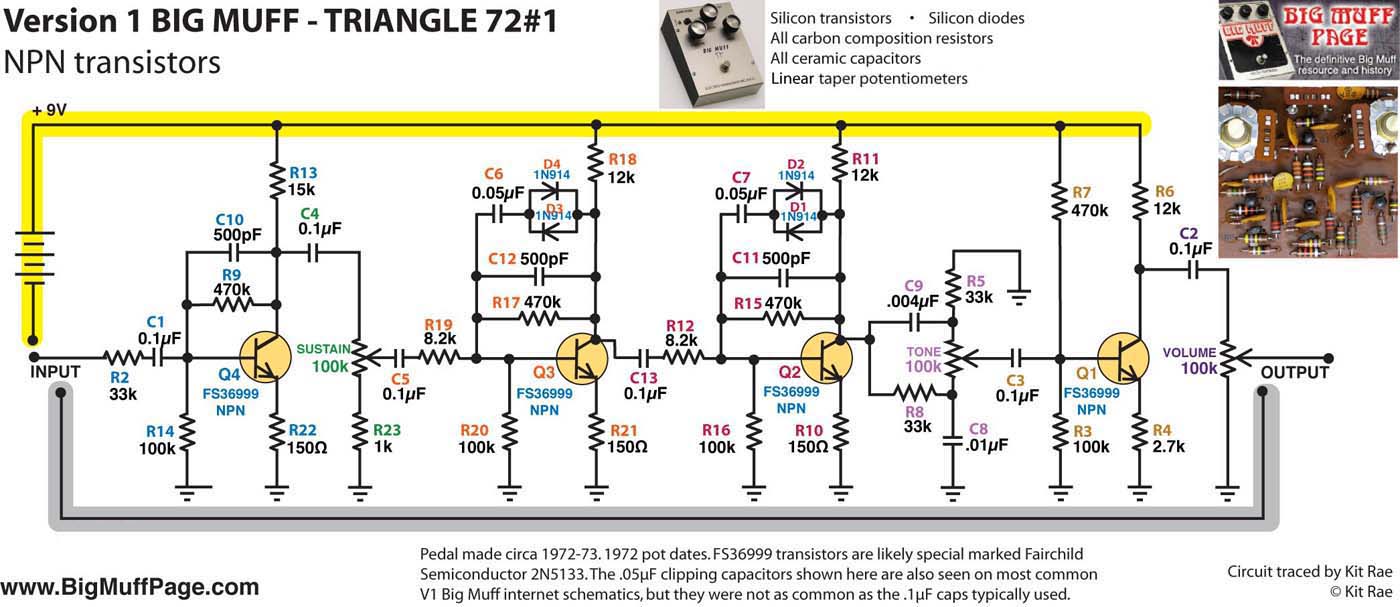
V1 TRIANGLE BIG MUFF PI - Another variant circa 1972 with .05uF clipping caps, and large 560pF filter caps. Those cut off more of the high frequencies than the 500pF's commonly used, making this one of the fatter sounding variants, with lots of bottom end. This variant was one of the first to be traced and posted on the world wide web. Even though it was actually not a common V1 circuit at all, most boutique BMP clones used this schematic. Still, it sounds very good and defined what people thought a Triangle Big Muff was supposed to sound like in the early days of boutique BMP cloning through the mid 1990's to the early 2000's. The Dice Works Muff Diver, BYOC Large Beaver Triangle V1, General Guitar Gadgets BMP Triangle, and many other Triangle clones were based on this circuit variant.
Note that the original Silicon diodes are marked SYL GD938, but the actual diode types used are unknown. 1N914 (shown on the schematic) and 1N4148 are some modern equivalents that work, but they may not be identical to the original diodes. The differences are minor, but diode types do affect the sound frequencies that are clipped.
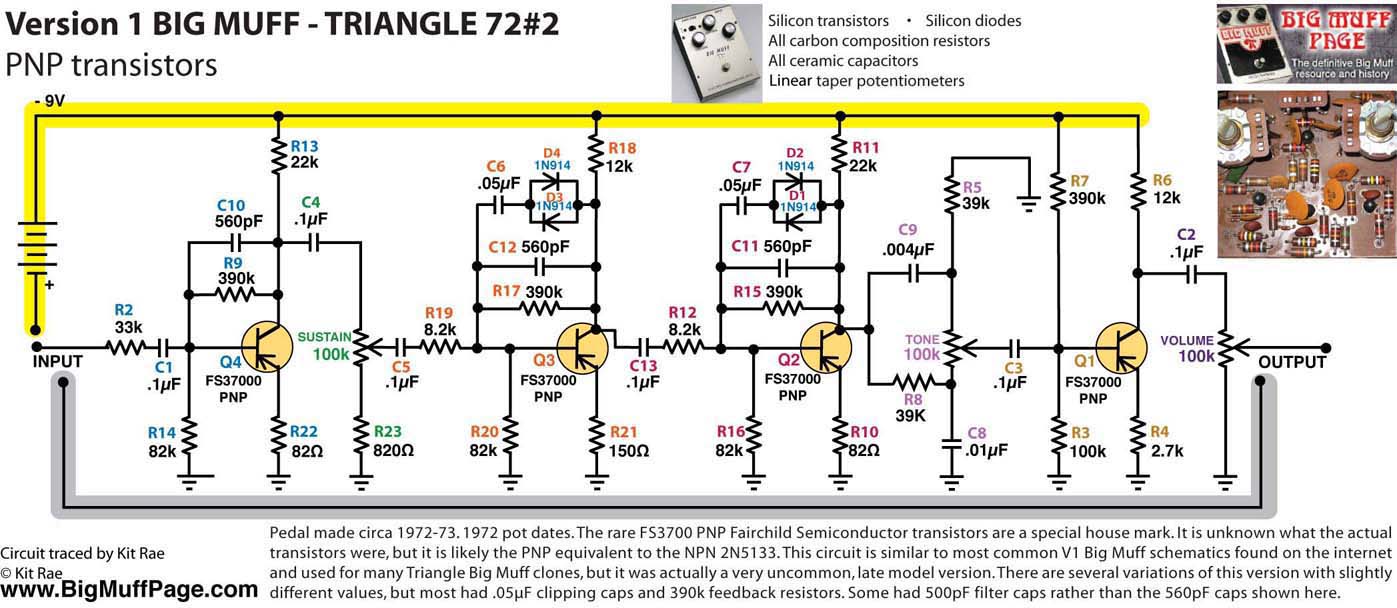
ELK BIG MUFF SUSTAINAR / SUPER FUZZ SUSTAINAR - Among the many Japanese Big Muff clones, one of the first on the market was the Super Fuzz Sustainar, a nearly exact clone of a 1972 era Big Muff made by the Hoshino Gakki company (early units possibly made by Miyuki Ind. Co.) sometime around 1973. It was housed in an identical enclosure to the V1 Big Muff with very similar graphics. These were sold throughout the 1970s, and not long after its introduction, Gakki shamelessly changed the name from Super Fuzz to Big Muff. The pedals marked Electro Sound are the earliest, and those marked Elk Incorporated or Elk/Gakki are the later made production.
The circuit is identical to a PNP triangle circuit from 1972, almost identical to the PNP circuit shown above. The only change made was the high pass cap in the tone section at C9. Typically .004µF, it was changed to 330pF in the Sustainar. This had the effect of retaining treble when the tone pot was turned to the bass side, making the bass range more useful. When fully in the bass position the overall volume level is significantly higher than other tone settings as well.
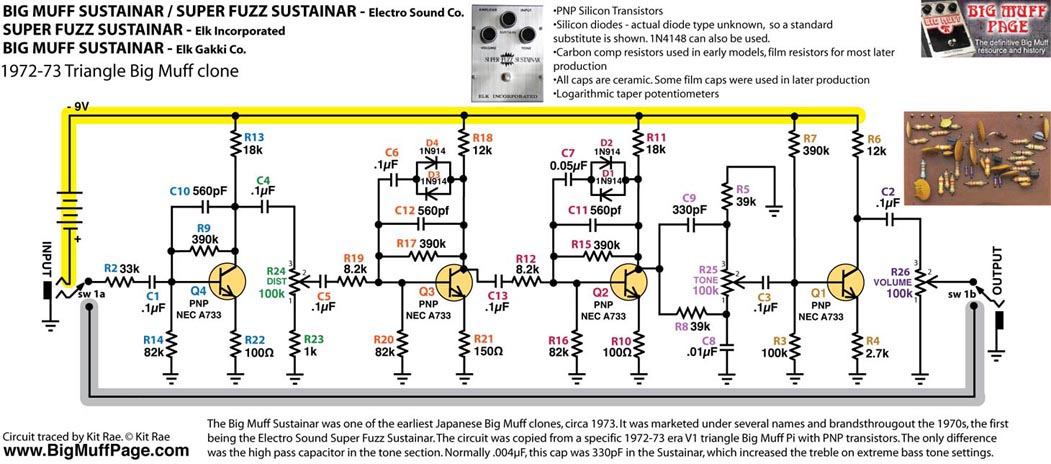
SEKOVA BIG MUFF by Shin Ei - Another Japanese builder that made a clone of the Big Muff was the effects company Shin Ei. They started making copies of popular western effects pedals under the Sekova brand around 1969, and this particular red boxed Big Muff clone, their model 2015, first appeared around 1972 or ‘73. It is basically an exact clone of a specific 1972 Big Muff circuit variant, and very similar to the Triangle 72#1 schematic shown above. This clone is extremely rare.
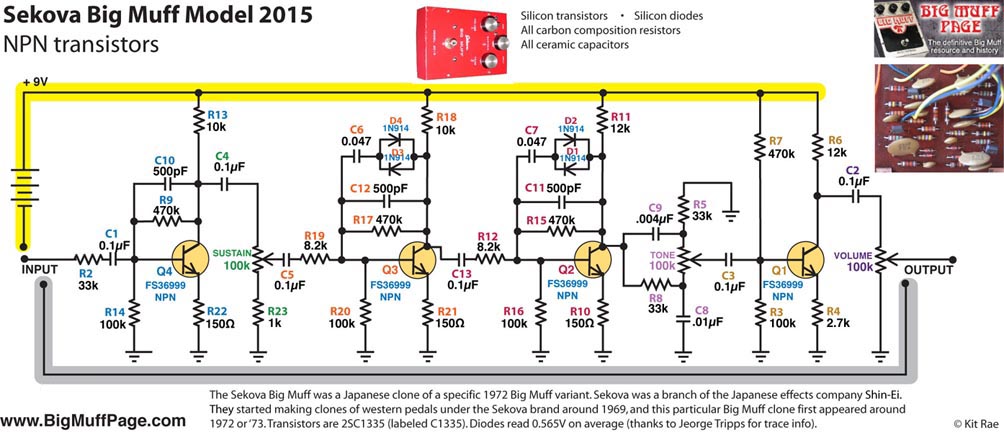
VERSION 2 "RAMS HEAD" BIG MUFF PI - Approximately 20 circuit variants exist, each made in extended manufacturing runs.
V2 "47" RAMS HEAD BIG MUFF PI - The first version of the V2 circuit to appear in the larger enclosure, introduced sometime in late 1972 - early 1973. Nicknamed the "47" version due to the number 47 appearing in most of the component values. Quite a different sound from the V1 circuit above, due to the The 500pF/560pF filter caps at C10, C11, C12 being changed to 470pF, and the large .47uF coupling and filter caps. The same circuit was also used in the Guild Foxey Lady version. For some interesting mods to this circuit, see the Pharoah BMP clone schematic here.
Note that most of the original Silicon diodes from this period are unknown, simply marked with a black band, but some were marked 125. 1N125 is a germanium diode, but these are Silicon. 1N914 (shown on the schematic) and 1N4148 are some modern equivalents that work, but they may not be identical to the original diodes. The differences are minor, but diode types do affect the sound frequencies that are clipped.
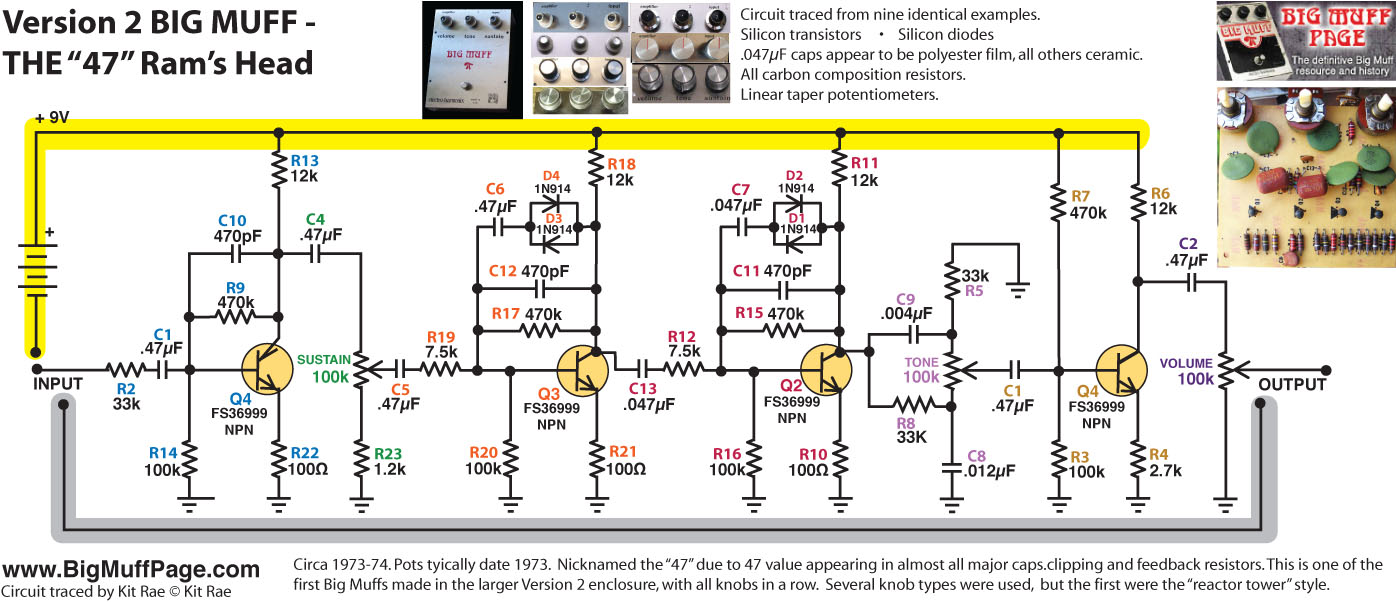
V2 "73" RAMS HEAD BIG MUFF PI - The second variant of the V2 circuit appeard circa 1973. All of the .047µF caps were replaced with .1 and .15µF. Very similar sound to the violet schematic that would follow. The more common version of this variant had .12µF coupling and clipping caps rather than .1µF shown here. The same circuit was also used in the Guild Foxey Lady OEM version. Several very good clones were based around this version, including the Stomp Under Foot '73 Ram's Head Classic Series and Pigeon FX Ram's Head.
Note that most of the original Silicon diodes from this period are unknown, simply marked with a black band, but some were maerked 125. 1N125 is a germanium diode, but these are Silicon. 1N914 (shown on the schematic) and 1N4148 are some modern equivalents that work, but they may not be identical to the original diodes. The differences are minor, but diode types do affect the sound frequencies that are clipped.
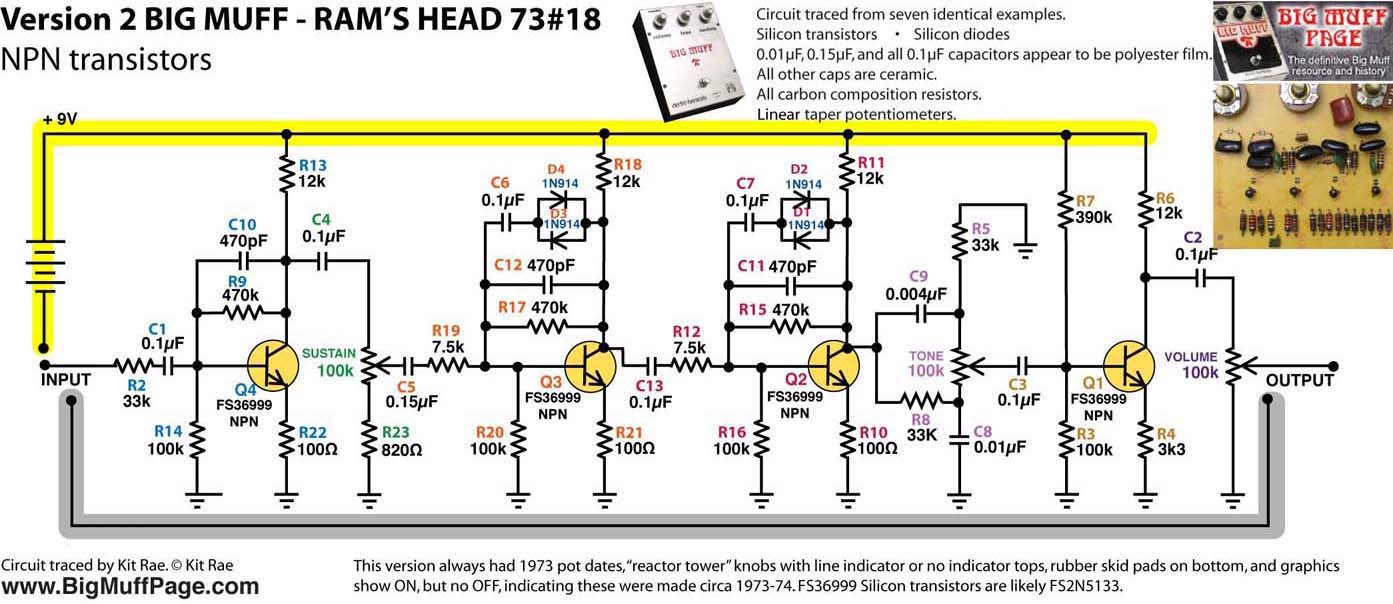
V2 "73" RAMS HEAD BIG MUFF PI - First Circle Face version - The third variant of the V2 circuit appeard circa 1973, with pots dated 1973. In my opinion, this is the closest sounding Big Muff to the one David Gilmour used in his live rigs, both solo and with Pink Floyd. It sounds very similar to the Cornish P-1 custom Big Muff, although aionfx.com has verified that the P-1 was actually a clone of the "box cap" (76#2) Ram's Head variant on the next page.
This circuit is usually seen in Big Muffs with the circle face logo, either with all black graphics, all red graphics, or all blue graphics. I think these were the first Big Muffs to use the circle face graphic, but this circuit was also found in the standard red/black V2, the OEM version made by EHX for Targ & Dinner of Chicago, branded as the Marveltone Distortion Sustainer, and the Guild Foxey Lady. The primary difference between this variant and the "violet" circuit variant below is that all of the collector resistors and the limiting resistors are 10k here. Nearly all the other values are identical to the violet circuit.
The FS36999 Silicon transistors are the type with the long F. Note that most of the original Silicon diodes from this period are unknown, simply marked with a black band, but some were maerked 125. 1N125 is a germanium diode, but these are Silicon. 1N914 (shown on the schematic) and 1N4148 are some modern equivalents that work, but they may not be identical to the original diodes. The differences are minor, but diode types do affect the sound frequencies that are clipped.
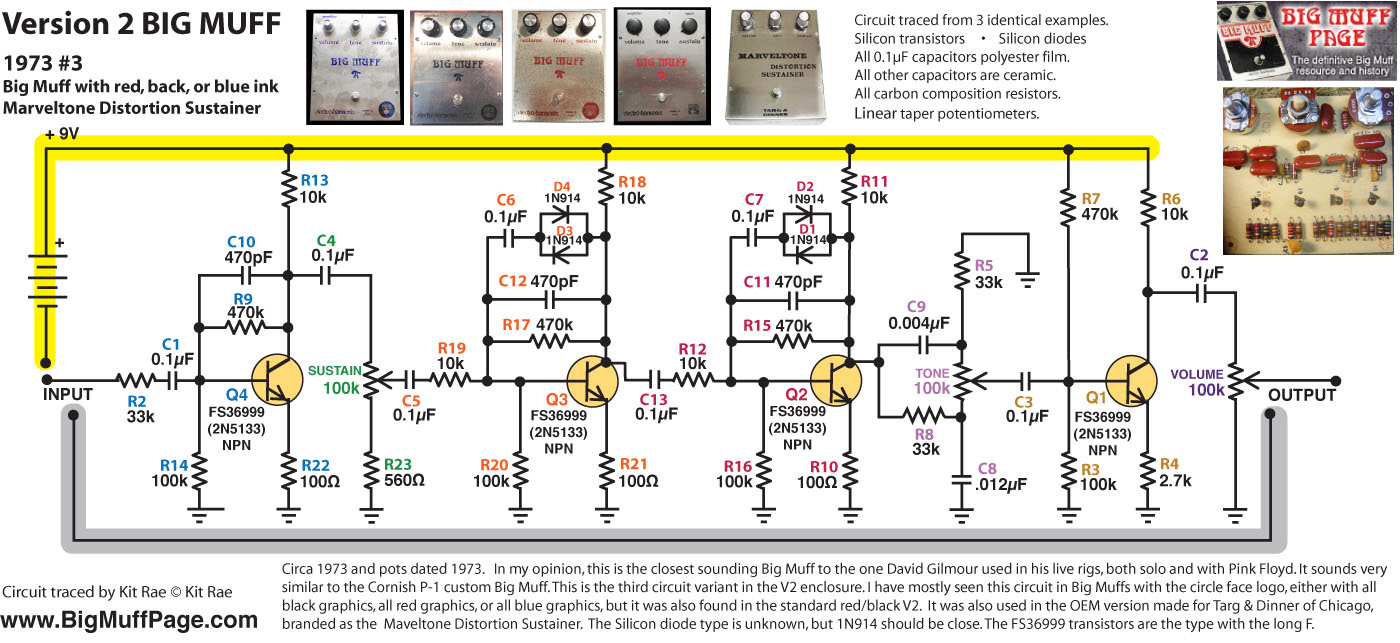
Below is the same circuit as above, but these are the actual measured part values. Each component was full or partially desoldered from the pcb board to measure the electrical value. Many of the values measured very differently from the printed values, especially the large ceramic capacitors and resistors. Those values were likely out of spec to begin with, but some of the parts may have drifted out of spec over time. Big thanks to EdN..
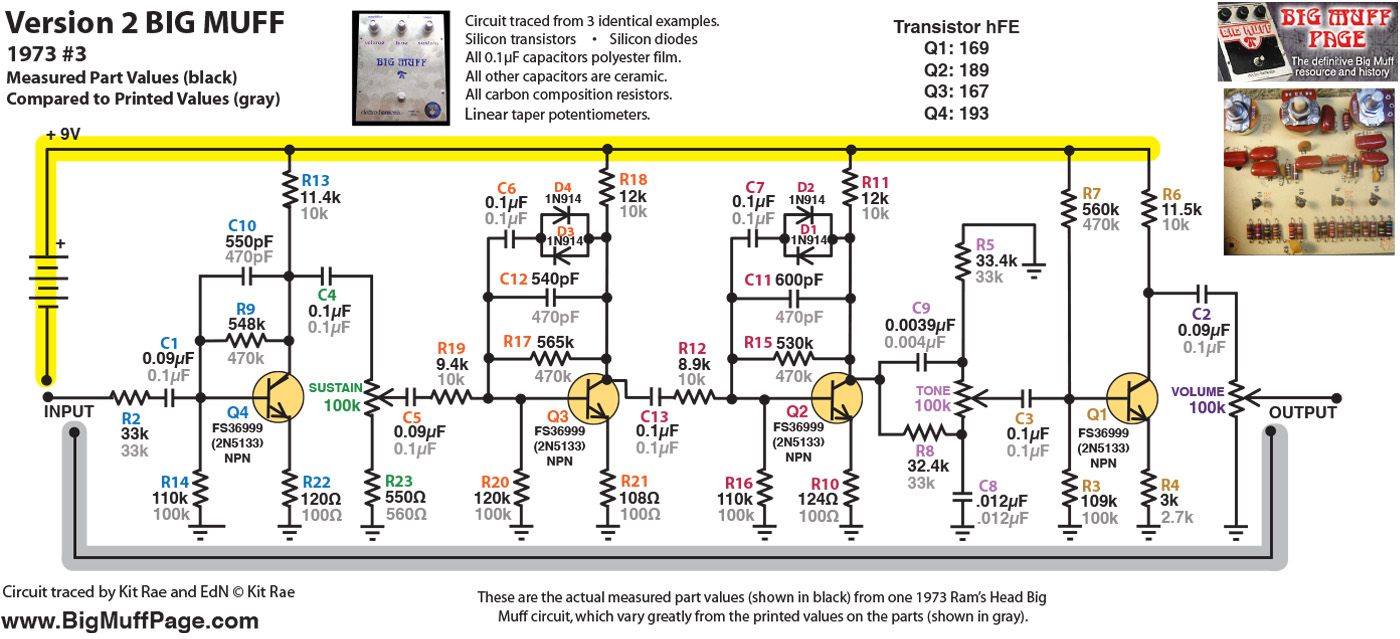
V2 "VIOLET" RAMS HEAD BIG MUFF PI / LYLE DISTORTION SUSTAINER / MARVELTONE DISTORTION SUSTAINER / GUILD FOXEY LADY - The fourth variant of the V2 circuit, and first of the so-called "violet" Big Muffs, due to the violet colored ink used. Most of these had violet, blue, or purple ink, and some very rare units were red. Arguably, the schematic shown above could also be said to be the first violet Big Muff, as it is nearly identical other than the collector resistors, but that version did not appear in as many Big Muffs with the blue or violet ink.
These are considered among the best sounding and most desirable of the 1970s Big Muffs, with a perfect balance of lows, highs, medium gain distortion, and a mid range that was not overly scooped. There were probably more of this V2 circuit variant made than any other. Very similar sound to the '73 schematic above, but with a larger resistor at the R7 voltage divider, smaller emitter resistor at R4, and slightly larger input resistors at R12 and R19 for a more refined bottom end. The same circuit was also used in the Guild Foxey Lady, Lyle Distortion Sustainer, and Marveltone Distortion Sustainer, OEM versions made by Electro-Harmonix. Numerous violet Big Muff boutique clones use this schematic.
Note that most of the original Silicon diodes from this period are unknown, simply marked with a black band, but some were marked 125. 1N125 is a germanium diode, but these are Silicon. 1N914 (shown on the schematic) and 1N4148 are some modern equivalents that work, but they may not be identical to the original diodes. The differences are minor, but diode types do affect the sound frequencies that are clipped.
The Electro-Harmonix Ram's Head Big Muff reissue from 2019 was reverse engineered from a 45 year old Ram's Head with this exact circuit, but many of the actual component values measured very differently from the printed values in the scheamtic below. Those values were likely out of spec to begin with, or drifted out of spec over time.
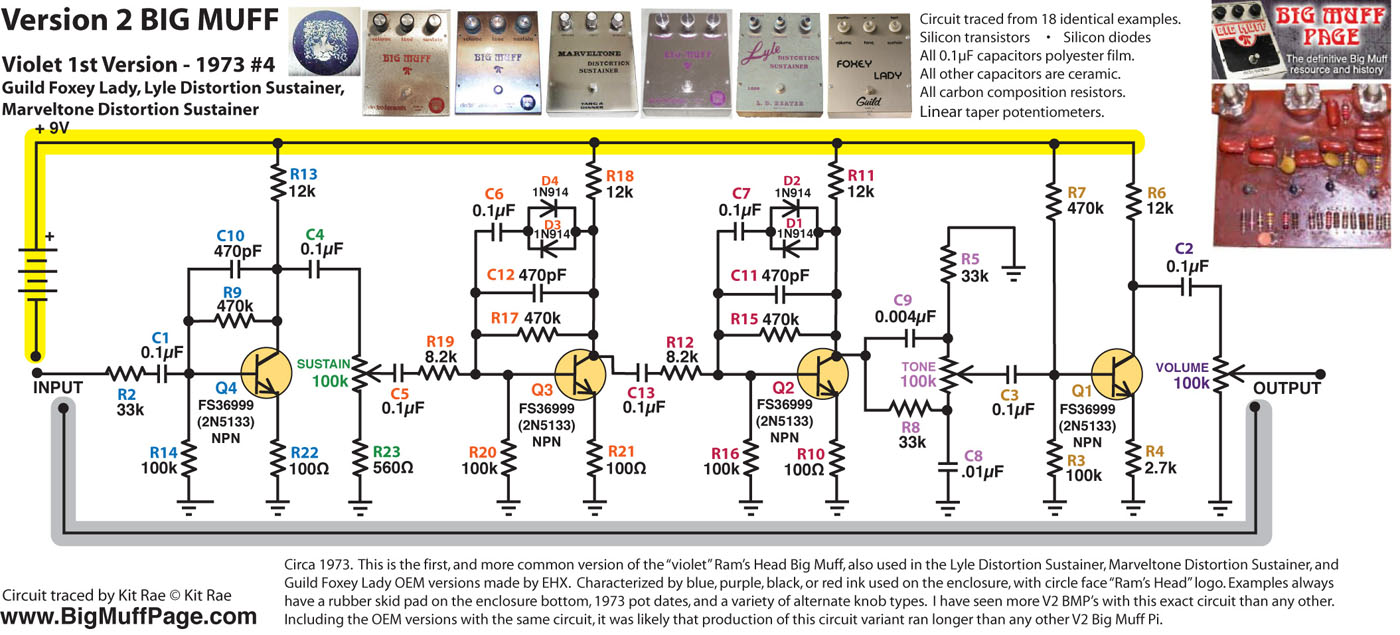
V2 "VIOLET" RAMS HEAD BIG MUFF PI - Second Version - Fifth variant of the V2 circuit. A revised version of the violet Big Muff shown above, circa 1974. Input and tone resistors were enlarged to 39k, the R7 voltage divider reduced to 390k, R11/R13 collector resisitors enlarged to 15k. The low pass filter cap and feedback filter caps at C10, 11, and C12 were enarged to 560pF, clipping more highs and making the lows sound fatter. This identical circuit was also made with 470pF filter caps in those three positions. The General Guitar Gadgets Violet Ram's Head, MJM Foxey Fuzz, and many other violet clones were based on the 470pF version of this schematic.
Note that most of the original Silicon diodes from this period are unknown, simply marked with a black band, but some were marked 125. 1N125 is a germanium diode, but these are Silicon. 1N914 (shown on the schematic) and 1N4148 are some modern equivalents that work, but they may not be identical to the original diodes. The differences are minor, but diode types do affect the sound frequencies that are clipped.
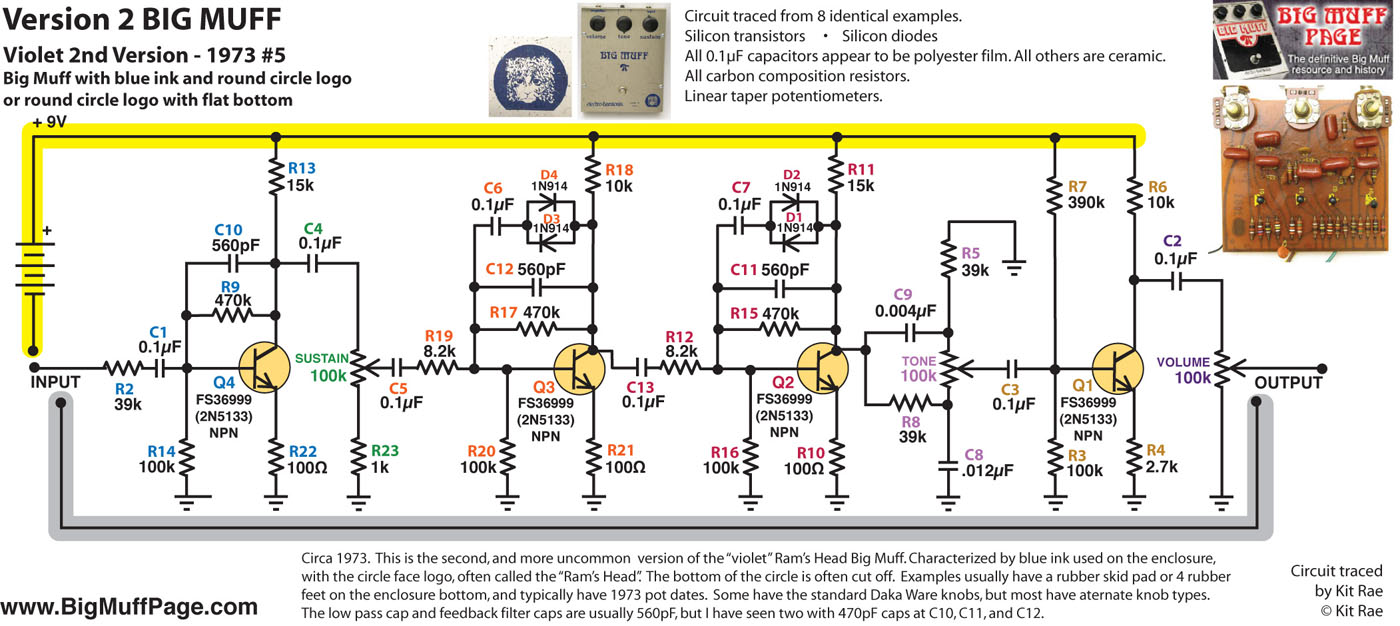
COLORSOUND SUPA TONEBENDER Modified Violet Ram's Head Big Muff - Around 1973 Sola Sound of London decided to clone the Big Muff for their Colorsound ToneBender line. The component values were copied from a 1973 violet era Big Muff, similar to those shown above, but with one major change. The coupling caps and clipping diodes in the first clipping stage were removed, making a very unique sounding Big Muff, and one that is very much fitting with the Tone Bender family of sounds. I have an early circuit board in my Supa that actually includes through holes in the first clipping stage for the missing cap and diodes, indicating Sola intended to originally make a straight clone of a violet Big Muff, or possibly had plans to do so later, but it does not appear any were made with the complete components. There is also an extra .1µF cap in the tone section at C14, and a polarized electro added to the 9v for power filtering, not found on the original violet BMP circuits.
I have written more about Colorsound and the Supa Tonebender here.
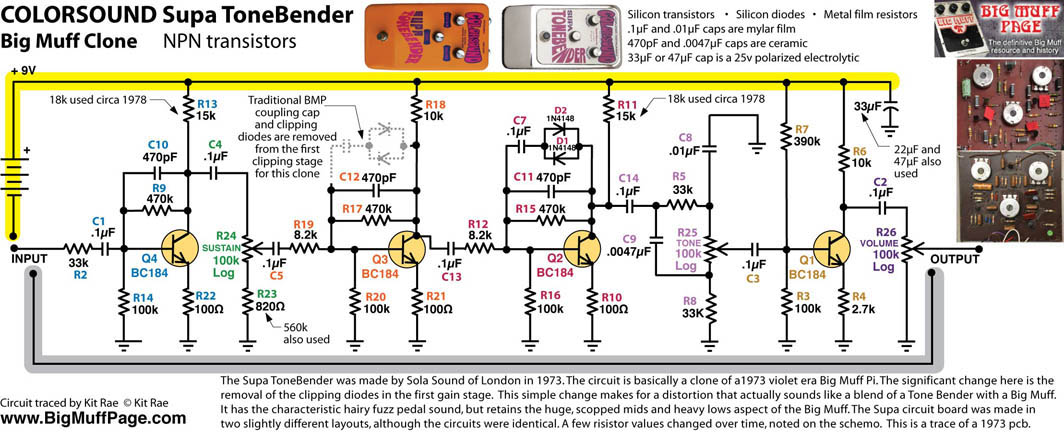
JEN JUMBO FUZZ - In 1973 Jen Elettronica, a large musical equipment manufacturer in Spain, got into the Big Muff clone market with the Jen Jumbo Fuzz. Jen was one of the largest OEM (original equipment manufacturer) musical manufacturers in the world at the time, so they also rebranded this pedal as the Dallas Arbiter Jumbo Fuzz, the Sam Ash Jumbo Fuzz, and Sam Ash Fuzzola II. Component values seem to be based on a few different V1 circuits, with the 470pF caps from the 1973 V2's thrown in for good measure. The really unique modification to this version of the circuit was the addition of a Germanium noise gate section (shown in blue), which is there to reduce noise, but can also give the muff some sputtery gated fuzz effects at the right settings. Unfortunately, the Sam Ash Jumbo, Fuzzola II, and some Jen Jumbo's did not include all of the gate components.
I have written more about Jen and the Jen Jumbo Fuzz here.
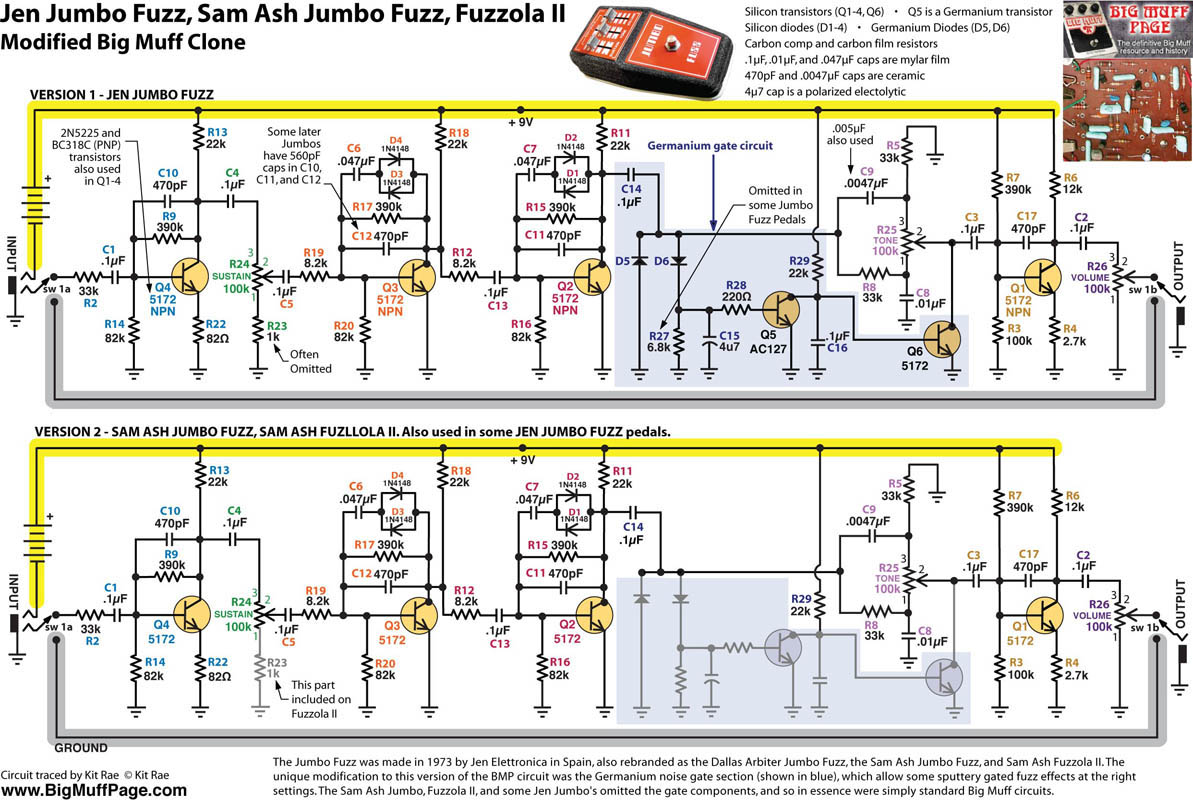
Kit’s Secret Guitar, Gear, and Music Page
Guitar stuff, gear stuff, soundclips, videos, Gilmour/Pink Floyd stuff, photos and other goodies.
Copyright Kit Rae.
VISIT MY SWORDS, KNIVES and FANTASY ART WEBSITE www.kitrae.net
This page is not authorized, affiliated, or associated with Electro Harmonix in any way.
Website and contents ©2007 and ©2012 Kit Rae. All rights reserved. Linking to this website is allowed, but copying the text content is strictly prohibited without prior authorization. No part of this work may be reproduced, stored in a retrieval system, or transmitted in any other form, or by any means, electronic, mechanical, photocopying, recording, computer networking, or otherwise without prior permission in writing from the copyright holder(s).






